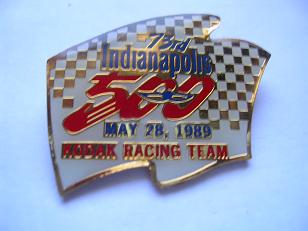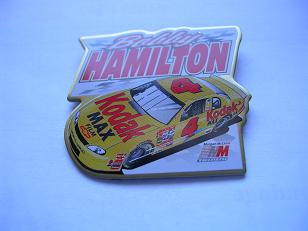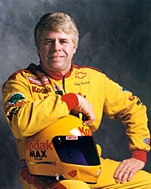
73 eme , 28 Mai 1989 73 rd (blue) 73 rd (red) 73 rd (red)




1989 Indianapolis Designed by Eastman 1989 Indianapolis Designed by Eastman
Motor Speedway Corp Kodak Co 89 Motor Speedway Corp Kodak Co 89
Made for Eastman Kodak Company Made for Eastman Kodak Company
74 eme , 27 Mai 1990 74 eme , 27 Mai 1990 75 eme , 26 Mai 1991 75 eme , 26 Mai 1991




CLK Productions for 1990 Indianapolis 1991 Indianapolis 1991 Eastman Kodak
Eastman Kodak Co Motor Speedway Corp Motor Speedway Corp
Made for Eastman Kodak Company Made for Eastman Kodak Company
76 eme , 24 Mai 1992 77 eme , 30 Mai 1993 78 eme , 29 Mai 1994



1992 Indianapolis 1993 Indianapolis 1994 Indianapolis
Motor Speedway Corp Motor Speedway Corp Motor Speedway Corp
Made for Eastman Kodak Company Made for Eastman Kodak Company
Racing at Indianapolis

Eastman Kodak Company 1994
Autres courses Indy
5 eme Toronto 1 er Vancouver
22 Juillet 2 Septembre 90


Kodak Canada Inc Kodak Canada Inc
International Motor Sports Association ( IMSA )
Watkins Glen 1988 Watkins Glen 1989
Nascar : National Association for Stock Car Auto Racing
| ROCHESTER, N.Y. (AP) (10/27/2008)— Eastman Kodak Co. is ending its 22-year sponsorship in NASCAR and putting more sports marketing dollars into professional golf. |
| The photography pioneer, betting its future on electronic imaging, said Monday the realignment fits better with a new effort to highlight its brand digitally, such as on PGA Tour scoreboards. |
| Kodak also wants to engage more customers overseas since 60 percent of its sales are outside the United States. |
| Kodak said it is also ending a four-year sponsorship of Penske Racing at year-end. |
| Since signing on with NASCAR in 1986, Kodak-sponsored cars have won the Daytona 500 four times - with Ryan Newman's car in 2008, Sterling Marlin's in 1994 and 1995 and Ernie Irvan's in 1991. |
| "Just as we have transformed our company, we are transforming our marketing," said Betty Noonan, Kodak's vice president of corporate marketing and branding. "We want to express our deepest thanks to our friends at NASCAR and Penske Racing for their partnership and support. We remain big fans." |
Kodak Film Racing



Design by Eastman Eastman Kodak Company 615-859-7944 Non signé
Kodak Co 92 1994 Ho Ho NYC Image N.M.S/Corp
Taiwan
Eastman Kodak Company 1992




Designed by Eastman Designed by Eastman Kodak Canada Inc Eastman Kodak Company
Kodak Co 91 Kodak Co 89 1995 China



Non signé 1991 Eastman Kodak Eastman Kodak Co 1992 GRS.INC Eastman Kodak Inc Taiwan
Le Daytona 500 est une course automobile américaine réservée aux voitures de type stock car qui se tient depuis 1959 à Daytona Beach en Floride. Il s'agit de l'épreuve la plus prestigieuse organisée par la NASCAR, ce qui lui vaut le surnom de « Super Bowl du NASCAR ». Elle ouvre chaque année au mois de février le championnat de Sprint Cup Series (anciennement Winston Cup et Nextel Cup) et se tient sur 500 miles (805 km), soit 200 tours de l'anneau de vitesse du Daytona International Speedway.
Depuis 1995, elle réalise des audiences télévisées supérieures aux 500 miles d'Indianapolis (épreuve réservée aux monoplaces), ce qui en fait la course automobile la plus prisée par les télespectateurs américains.

Ernie Irvan (1990 - 1993)
| 1991 | Ernie Irvan | 4 | Chevrolet |




Design by Eastman Non signé Eastman Kodak Co 1993 N.M.S / Corp Image
Kodak Co 92 615-859-7944


1991 Eastman Kodak Union Made 66390 Made in USA N.M.S / Corp Image
615-859-7944
Sterling Marlin (1994 - 1997)
| 1994 | Sterling Marlin | 4 | Chevrolet |
| 1995 | Sterling Marlin | 4 | Chevrolet |




Union Made USA Wincraft Racing Design 1 Wincraft Racing Design 3 CRS INC Eastman Kodak Company Eastman Kodak Company Eastman Kodak INC
Made in China Made in China 804-572-8367 Taiwan




GRS INC Wincraft Inc Winona MN Under license by Eastman Kodak GRS INC
Eastman Kodak Co Taiwan 55987 USA Wincraft Made in China Eastman Kodak Co Taiwan



1994 Action Packed SME Wincraft Inc - Winona Mn Taiwan Eastman Kodak Company
55987 USA 1995
Taiwan
Bobby Hamilton (1998 - 2000)




Eastman Kodak Company Action Sports Image,LLC Nascar 2000 Wincraft Racing Design
Action Sports Image,LLC Nascar 2000 Eastman Kodak Company Eastman Kodak Company
1999 - Pro Specialities Eastman Kodak Company Action Sports Image,LLC 1998 Made in China
San Diego - China China China


Wincraft Racing Design Wincraft Racing Design
Eastman Kodak Company Eastman Kodak Company
1998 Made in China 1998 Made in China
Robby Gordon (2001)

Wincraft Racing Design
Eastman Kodak Company
2001 Made in China
Kevin Lepage
Non signé
Winners Circle

Winners Circle Nascar Non signé NASCAR Penske Racing South
Eastman Kodak Eastman Kodak
Company 2005 Company 2004
Rusty Wallace - Penske Racing South - 2004
Winners Circle Nascar
Eastman Kodak
Company 2004
Michigan : Aug 19 2005

Effort Results Wincraft Racing
Made in China
| 2008 | Ryan Newman | 12 | Dodge |

1986
 MMM and its new
driver, 33-year-old Rick Wilson, get a strong start to the 1986 season with a
seventh-place finish in the season-opening Daytona 500 and an eighth-place
finish at Talladega in May.
MMM and its new
driver, 33-year-old Rick Wilson, get a strong start to the 1986 season with a
seventh-place finish in the season-opening Daytona 500 and an eighth-place
finish at Talladega in May.
In June, MMM unloads what would become the
familiar yellow #4 Oldsmobile with a sponsorship from Kodak. It signals the
beginning of the Kodak/MMM partnership that lasts for 18 years – one of the
longest sponsorships in the NNCS garage behind STP’s backing of “The King”
Richard Petty.
After qualifying 10th and finishing eighth at Michigan,
Wilson and MMM record four more top-10 qualifying efforts and three additional
top-20 finishes during the remainder of the season.

1988
MMM
earns its first pole position at Bristol International Raceway (now Bristol
Motor Speedway), the team’s home track in Bristol, Tenn. Wilson puts the Kodak
machine in the top qualifying spot with a speed of 117.552 mph.
In July,
the Kodak Oldsmobile stays in the spotlight all day in the Pepsi 400 at Daytona
International Speedway. Wilson leads the field for 19 laps before finishing
second by a mere three feet to Bill Elliott. The finish is a career-best for
Wilson and MMM.
The team’s first full season on the tour is highlighted
by two top-fives and five top-10s for a 21st place finish in the final point
standings and more than $200,000 in earnings.
1990
 In one of the most pivotal
moves in team history, MMM hires Ernie Irvan to drive the No. 4 entry. Irvan
recorded a top-10 finish in his first NNCS start in a Dale Earnhardt-owned car
at Richmond International Raceway in 1987.
In one of the most pivotal
moves in team history, MMM hires Ernie Irvan to drive the No. 4 entry. Irvan
recorded a top-10 finish in his first NNCS start in a Dale Earnhardt-owned car
at Richmond International Raceway in 1987.
The MMM-Irvan partnership is
the opportunity for both team and driver to realize the potential many believe
they have.
In his first race with the team, Irvan drives the Kodak
Oldsmobile from the 30th starting spot to a third-place finish at Atlanta
International Raceway (now Atlanta Motor Speedway).
Less than a month
later, Irvan earns his first career pole position where the MMM team won its
first career pole - Bristol Motor Speedway.
In a move that emphasizes
the team’s growing status in the sport, MMM makes the decision to switch to
Chevrolet, believing the change will boost manufacturer support.
MMM and
Irvan follow up on their pole position in the spring race at Bristol by winning
the night race at the famed half-mile oval, the first victory for both team and
driver. In just his 17th start with the team, Irvan and MMM celebrate in front
of a hometown crowd of nearly 60,000.
The 1990 season is highlighted by
one win, six top-fives, 13 top-10s and three poles. The No. 4 team also records
more than $530,000 in earnings and finishes ninth in the championship point
standings.
1991
 MMM catapults into the spotlight by winning not only the
first race of the year, but the biggest. Irvan leads the field for 29 laps to
win the “Great American Race,” the Daytona 500.
MMM catapults into the spotlight by winning not only the
first race of the year, but the biggest. Irvan leads the field for 29 laps to
win the “Great American Race,” the Daytona 500.
After being penalized at
the start of the race, Irvan charges from the last starting position to win the
Budweiser at the Glen in Watkins Glen, N.Y. The win gives the team a diverse
portfolio with its first three wins on a half-mile track (Bristol Motor
Speedway), a 2.5-mile track (Daytona International Speedway) and a 2.45-mile
road course.
By season’s end, MMM and Irvan have recorded two victories,
11 top-fives and 19 top-10s for a fifth-place spot in the season’s final
standings. The team has also secured more than $1 million in earnings and a
premier place on the stage at the season-ending awards banquet at the
Waldorf-Astoria in New York.
1992
 MMM and Irvan capture three wins in an eight-week period in
June and July.
MMM and Irvan capture three wins in an eight-week period in
June and July.
In June, MMM wins at Sears Point International Raceway
(now Infineon Raceway), the circuit’s other road course in Sonoma, Calif. In
July, MMM picks up its second win at Daytona in the Pepsi 400, where it nearly
won its first race four years earlier. Three weeks later, the team visits
victory lane at Talladega Superspeedway.
The 1992 season features three
poles, nine top-fives and 11 top-10s for an 11th-place finish in the point
standings.
1993
 MMM and Irvan record a pair of top-five finishes in the
season’s first four races, and the No. 4 Kodak Chevrolet is back in victory lane
at Talladega in May, giving the team back-to-back wins on NASCAR’s largest
superspeedway. One month later, Irvan and MMM win the pole for the June event at
Dover International Speedway.
MMM and Irvan record a pair of top-five finishes in the
season’s first four races, and the No. 4 Kodak Chevrolet is back in victory lane
at Talladega in May, giving the team back-to-back wins on NASCAR’s largest
superspeedway. One month later, Irvan and MMM win the pole for the June event at
Dover International Speedway.
The team’s dominance on superspeedways
continues when it wins the pole in July for the Pepsi 400 at Daytona
International Speedway.
By the time the curtain closes on the 1993 season,
MMM has recorded one win, seven top-fives, eight top-10s and two
poles.
1994
 Before the 1994 season, MMM announces Sterling Marlin as
its new driver. Marlin, the son of former NASCAR driver Coo Coo Marlin, had won
the Rookie of the Year title in NASCAR’s top series in 1983. After 11 years and
278 races, Marlin had yet to win.
Before the 1994 season, MMM announces Sterling Marlin as
its new driver. Marlin, the son of former NASCAR driver Coo Coo Marlin, had won
the Rookie of the Year title in NASCAR’s top series in 1983. After 11 years and
278 races, Marlin had yet to win.
Marlin’s winless drought comes to an
end in his first race with MMM as the team wins its second Daytona 500 and
Marlin earns his first career win in 279 starts.
MMM and Marlin follow up
on their Daytona 500 victory with a second-place effort the following week at
North Carolina Motor Speedway in Rockingham, N.C.
The impressive start
results in a season total of five top-fives, 11 top-10s, one pole, and a
14th-place finish in the final point standings for more than $1.1 million in
earnings.
1995
 MMM and
Marlin kick off the season by winning the sport’s most prestigious race, the
Daytona 500. It’s the third Daytona 500 win for MMM in five years and makes
Marlin the third driver in NASCAR history to win the race two years in a
row.
MMM and
Marlin kick off the season by winning the sport’s most prestigious race, the
Daytona 500. It’s the third Daytona 500 win for MMM in five years and makes
Marlin the third driver in NASCAR history to win the race two years in a
row.
Four races later, MMM visits the winner’s circle at the series’
oldest track, Darlington Raceway in Darlington, S.C. In July, the team picks up
its third win of the year by winning from the pole at Talladega
Superspeedway.
At the end of the 31-race season, the team has earned a
career-best third place finish in the point standings after claiming three wins,
nine top-fives, 22 top-10s and one pole for more than $2.2 million in earnings.
1996
 In
its quest to become the first team in NASCAR history to win the “Great American
Race” three years in a row, MMM settles for a 40th-place finish after
experiencing engine trouble in the season opening Daytona 500.
In
its quest to become the first team in NASCAR history to win the “Great American
Race” three years in a row, MMM settles for a 40th-place finish after
experiencing engine trouble in the season opening Daytona 500.
In the
season’s ninth race, Marlin leads 48 laps to win the Winston Select 500 at
Talladega. Six races later, Marlin qualifies second after leading 88 of 117 laps
to win the Pepsi 400 at Daytona International Speedway in July.
At
season’s end, Marlin and the No. 4 Morgan-McClure Kodak Chevrolet are eighth in
the final point standings after posting five top-fives and 10 top-10s.
1998
 MMM kicks off NASCAR’s
50th anniversary year by naming Nashville, Tenn., native and short-track ace
Bobby Hamilton as the driver of the No. 4 Kodak Chevrolet.
MMM kicks off NASCAR’s
50th anniversary year by naming Nashville, Tenn., native and short-track ace
Bobby Hamilton as the driver of the No. 4 Kodak Chevrolet.
Hamilton, a
NNCS winner in the 1996 and 1997 seasons with Petty Enterprises, begins the year
with a respectable 12th-place finish at Daytona and ninth-place run at
Rockingham.
In his eighth race with the team, Hamilton puts the Kodak MAX
Film Chevrolet on the pole and wins in dominating fashion at Martinsville, Va.,
after leading 378 of 500 laps.
MMM rounds out the 1998 season with two
more top-fives and six more top-10s, including four top-15 finishes in the final
five races. In addition, the team claims almost $2.1 million in earnings and
finishes 10th in the season point standings.
2001-2002
 NASCAR veterans Kevin Lepage and former NASCAR Craftsman
Truck Series champion Mike Skinner share driving duties for MMM, racking up 11
top-20 finishes and a sixth-place run at Rockingham in November
2002.
NASCAR veterans Kevin Lepage and former NASCAR Craftsman
Truck Series champion Mike Skinner share driving duties for MMM, racking up 11
top-20 finishes and a sixth-place run at Rockingham in November
2002.
2003
 MMM celebrates its 20th Anniversary
and switches to the Pontiac Grand Prix after a 12-year relationship with
Chevrolet.
MMM celebrates its 20th Anniversary
and switches to the Pontiac Grand Prix after a 12-year relationship with
Chevrolet.
For the first time in the team’s history, MMM enters a second
car for the August race at Watkins Glen International. P.J. Jones is behind the
wheel of the No. 4 car, and Johnny Miller pilots the No. 04 Kodak Easy Share
Pontiac Grand Prix.
MMM records seven top-20 finishes on the season,
highlighted by an 11th-place finish at Darlington in
March.
2004
 MMM begins the season by switching manufacturers and NNC
veteran Jimmy Spencer records nine top-25 finishes in the No. 4 Chevrolet Monte
Carlo.
MMM begins the season by switching manufacturers and NNC
veteran Jimmy Spencer records nine top-25 finishes in the No. 4 Chevrolet Monte
Carlo.
Eric McClure, son of MMM co-owner Jerry McClure, drives the team’s
second car to a 26th-place finish in his NNC debut at Talladega
Superspeedway.
By the end of the year, MMM totals more than $2.1 million
in earnings.
In 2004, Gaughan moved up to the NEXTEL Cup, driving the No. 77 Eastman Kodak Dodge for Penske-Jasper Racing. He finished second in the Rookie of the Year standings, and 28th in the final points standings. He finished the season with 4 Top 10's including a career best top five finish Talladega Superspeedway, where he had been in contention to win before Dale Earnhardt, Jr. and a number of other drivers shuffled Gaughan back to fourth place. He did come close to a win at the Glen where he led a total of 7 laps in the final 25 laps. He then spun out with 19 laps to go and then broke a transmission, finishing 34th.
He was replaced at the end of the season by Travis Kvapil.
In 2005, Kvapil took over the Penske's #77 Kodak Dodge full-time, replacing Brendan Gaughan.[12] Kvapil scored his first ever Nextel Cup Series top-10 at Brisol Motor Speedway when he finished seventh during the Food City 500.[13] He picked up another top-10 at Phoenix International Raceway during the Checker Auto Parts 500. The two top-10 finishes pushed Kvapil to finish 33rd in the point standings during his first season in the series. When the season ended, the Penske Racing No. 77 team temporarily disbanded when Kodak pulled out of the sponsorship deal.[14][15]
Retour Themes